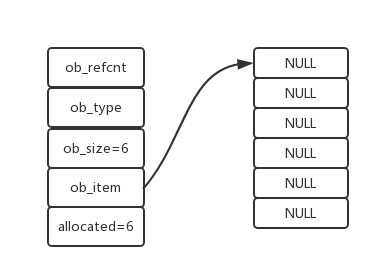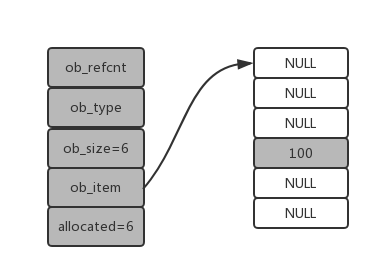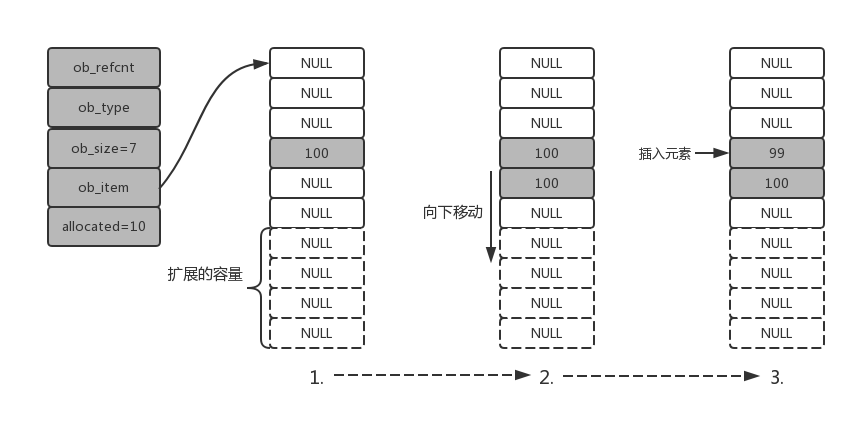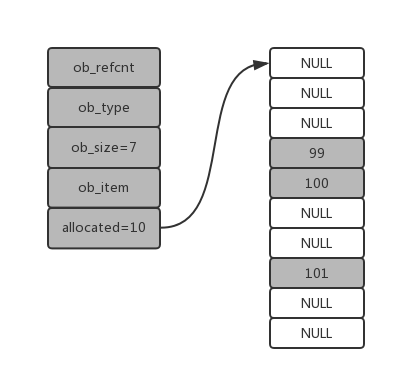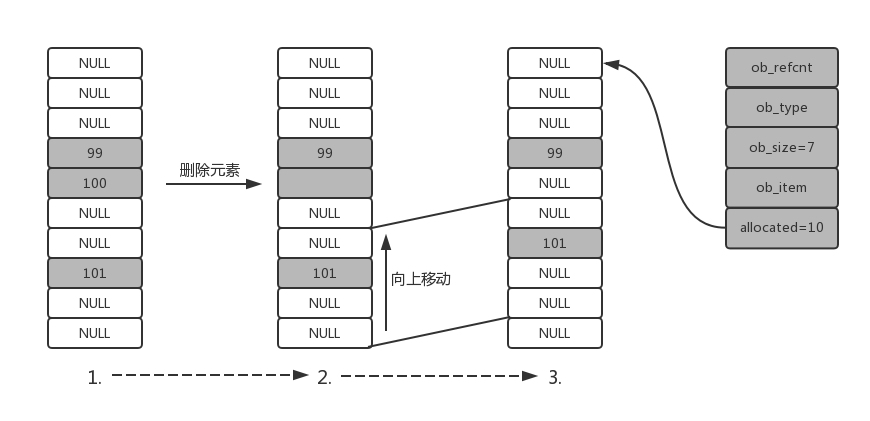1. PyListObject对象 PyListObject对象可以插入, 添加, 删除元素, 存放的都是PyObject*指针, 因此PyListObject是一个变长对象. 但和PyStringObject不同, PyListObject支持插入删除, 并动态的调整内存和元素.
typedef struct { PyObject_VAR_HEAD PyObject **ob_item; Py_ssize_t allocated; } PyListObject;
2. PyListObject对象的创建与维护 2.1 创建对象 PyListObject只提供了一种创建对象的方式: PyList_New, 参数size指定了元素的个数
PyObject* PyList_New (Py_ssize_t size) { PyListObject *op; size_t nbytes; if (size < 0 ) { PyErr_BadInternalCall(); return NULL ; } nbytes = size * sizeof (PyObject *); if (size > PY_SIZE_MAX / sizeof (PyObject *)) return PyErr_NoMemory(); if (num_free_lists) { num_free_lists--; op = free_lists[num_free_lists]; _Py_NewReference((PyObject *)op); } else { op = PyObject_GC_New(PyListObject, &PyList_Type); if (op == NULL ) return NULL ; } if (size <= 0 ) op->ob_item = NULL ; else { op->ob_item = (PyObject **) PyMem_MALLOC(nbytes); if (op->ob_item == NULL ) { Py_DECREF(op); return PyErr_NoMemory(); } memset (op->ob_item, 0 , nbytes); } op->ob_size = size; op->allocated = size; _PyObject_GC_TRACK(op); return (PyObject *) op; }
PyList_New仅仅指定元素的个数, 而不是元素实际占用的内存空间. 创建过程中, 先为PyListObject申请空间, 再为维护的元素列表申请内存, 通过ob_item建立联系.PyListObject对象时, 先检查缓冲池free_lists中是否有可用对象. 如果有, 则直接使用该对象; 若都不可用, 则通过PyObject_GC_New在系统堆中申请内存. 默认情况下, free_lists会维护80个PyListObject对象:
#define MAXFREELISTS 80 static PyListObject* free_lists[MAXFREELISTS];static int num_free_lists = 0 ;
2.2 设置元素 创建第一个PyListObject时, num_free_lists为0, 所以会绕过对象缓冲池而调用PyObject_GC_New, 在系统堆上创建一个新的PyListObject对象. 假设我们创建的PyListObject包含了6个元素, 也就是PyList_New(6), 创建完毕后的状态如下:
运行list[3]=100时会调用PyList_SetItem:
int PyList_SetItem (register PyObject *op, register Py_ssize_t i, register PyObject *newitem) { register PyObject* olditem; register PyObject** p; if (!PyList_Check(op)) { Py_XDECREF(newitem); PyErr_BadInternalCall(); return -1 ; } if (i < 0 || i >= ((PyListObject *)op) -> ob_size) { Py_XDECREF(newitem); PyErr_SetString(PyExc_IndexError, "list assignment index out of range" ); return -1 ; } p = ((PyListObject *)op) -> ob_item + i; olditem = *p; *p = newitem; Py_XDECREF(olditem); return 0 ; }
将新的元素指针移到list中后, 需将原来存放的对象的引用计数-1. 由于olditem可能为NULL, 所以应先调用Py_XDECREF, 完毕后的状态如下:
2.3 插入元素 设置元素不能改变PyListObject对象的内存, 但插入元素可以改变ob_item指向的内存.
int PyList_Insert (PyObject *op, Py_ssize_t where, PyObject *newitem) { if (!PyList_Check(op)) { PyErr_BadInternalCall(); return -1 ; } return ins1((PyListObject *)op, where, newitem); } static int ins1 (PyListObject *self, Py_ssize_t where, PyObject *v) { Py_ssize_t i, n = self->ob_size; PyObject **items; if (v == NULL ) { PyErr_BadInternalCall(); return -1 ; } if (n == PY_SSIZE_T_MAX) { PyErr_SetString(PyExc_OverflowError, "cannot add more objects to list" ); return -1 ; } if (list_resize(self, n+1 ) == -1 ) return -1 ; if (where < 0 ) { where += n; if (where < 0 ) where = 0 ; } if (where > n) where = n; items = self->ob_item; for (i = n; --i >= where; ) items[i+1 ] = items[i]; Py_INCREF(v); items[where] = v; return 0 ; }
下面是PyListObject对象扩充容量的方法:
static int list_resize (PyListObject *self, Py_ssize_t newsize) { PyObject **items; size_t new_allocated; Py_ssize_t allocated = self->allocated; if (allocated >= newsize && newsize >= (allocated >> 1 )) { assert(self->ob_item != NULL || newsize == 0 ); self->ob_size = newsize; return 0 ; } new_allocated = (newsize >> 3 ) + (newsize < 9 ? 3 : 6 ); if (new_allocated > PY_SIZE_MAX - newsize) { PyErr_NoMemory(); return -1 ; } else { new_allocated += newsize; } if (newsize == 0 ) new_allocated = 0 ; items = self->ob_item; if (new_allocated <= ((~(size_t )0 ) / sizeof (PyObject *))) PyMem_RESIZE(items, PyObject *, new_allocated); else items = NULL ; if (items == NULL ) { PyErr_NoMemory(); return -1 ; } self->ob_item = items; self->ob_size = newsize; self->allocated = new_allocated; return 0 ; }
list.insert(3, 99)运行的步骤图如下:
PyListObject对象还提供了append操作, 该操作与insert类似, 但只能在list的末尾插入. list.append(101)的运行结果如下:
2.4 删除元素 以下为删除元素:
>>> lst = [1 ,2 ,3 ,4 ]>>> lst[1 , 2 , 3 , 4 ] >>> lst.remove(3 )>>> lst[1 , 2 , 4 ]
remove()会调用listmove():
static PyObject* listremove (PyListObject *self, PyObject *v) { Py_ssize_t i; for (i = 0 ; i < self->ob_size; i++) { int cmp = PyObject_RichCompareBool(self->ob_item[i], v, Py_EQ); if (cmp > 0 ) { if (list_ass_slice(self, i, i+1 , (PyObject *)NULL ) == 0 ) Py_RETURN_NONE; return NULL ; } else if (cmp < 0 ) return NULL ; } PyErr_SetString(PyExc_ValueError, "list.remove(x): x not in list" ); return NULL ; }
PyObject_RichCompareBool负责对比元素, list_ass_slice负责删除该元素. list.remove(100)的运行如下:
3. PyListObject对象缓存池 以下是PyListObject被销毁的过程:
static void list_dealloc (PyListObject *op) { Py_ssize_t i; PyObject_GC_UnTrack(op); Py_TRASHCAN_SAFE_BEGIN(op) if (op->ob_item != NULL ) { i = op->ob_size; while (--i >= 0 ) { Py_XDECREF(op->ob_item[i]); } PyMem_FREE(op->ob_item); } if (num_free_lists < MAXFREELISTS && PyList_CheckExact(op)) free_lists[num_free_lists++] = op; else op->ob_type->tp_free((PyObject *)op); Py_TRASHCAN_SAFE_END(op) }
这里我们可以看到, 释放PyListObject对象中所有元素后, 会试图将空的PyListObject加入到free_lists中. 下一次创建新的list时, 可使用该PyListObject对象, 并重新分配空间, 避免了再次初始化.
